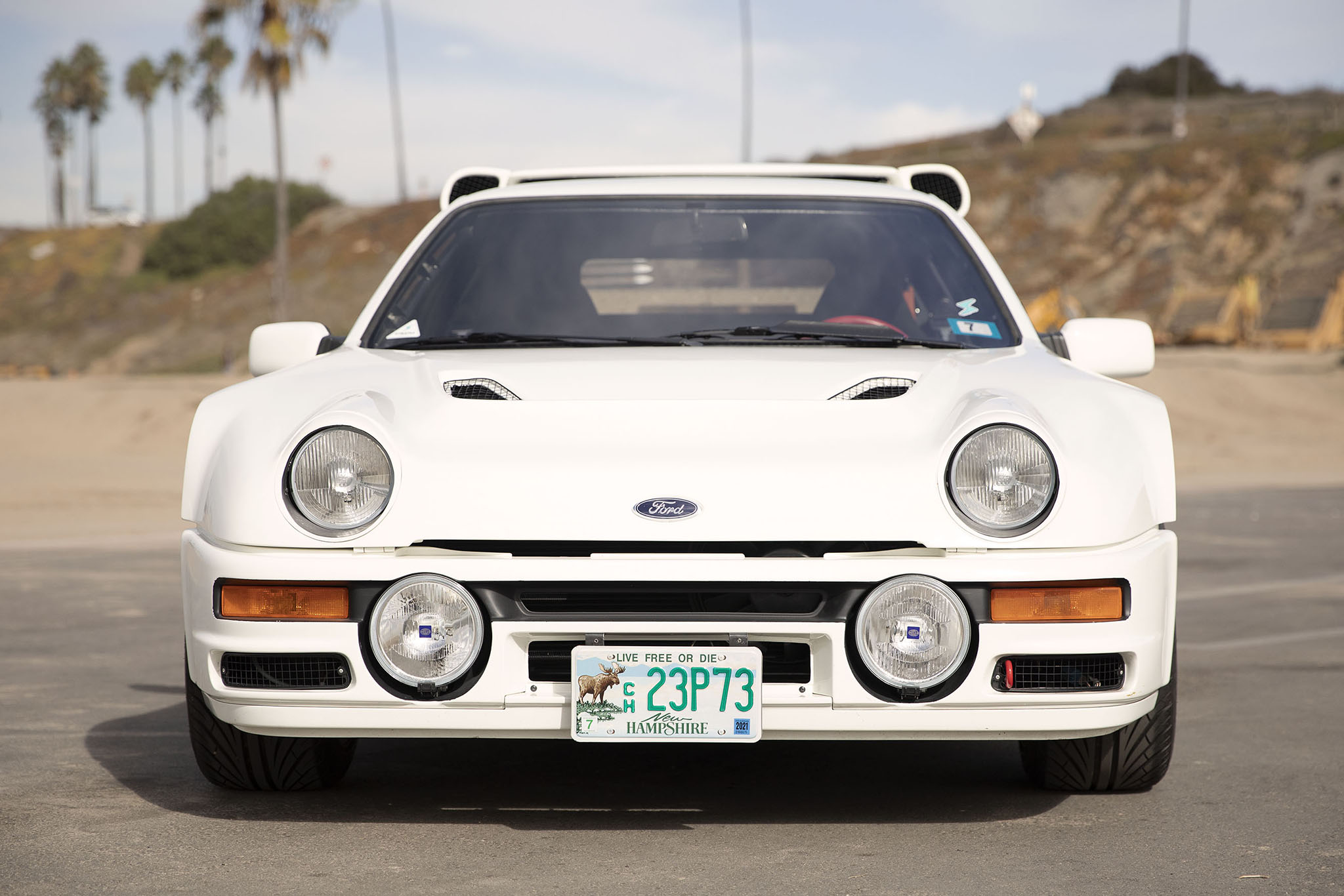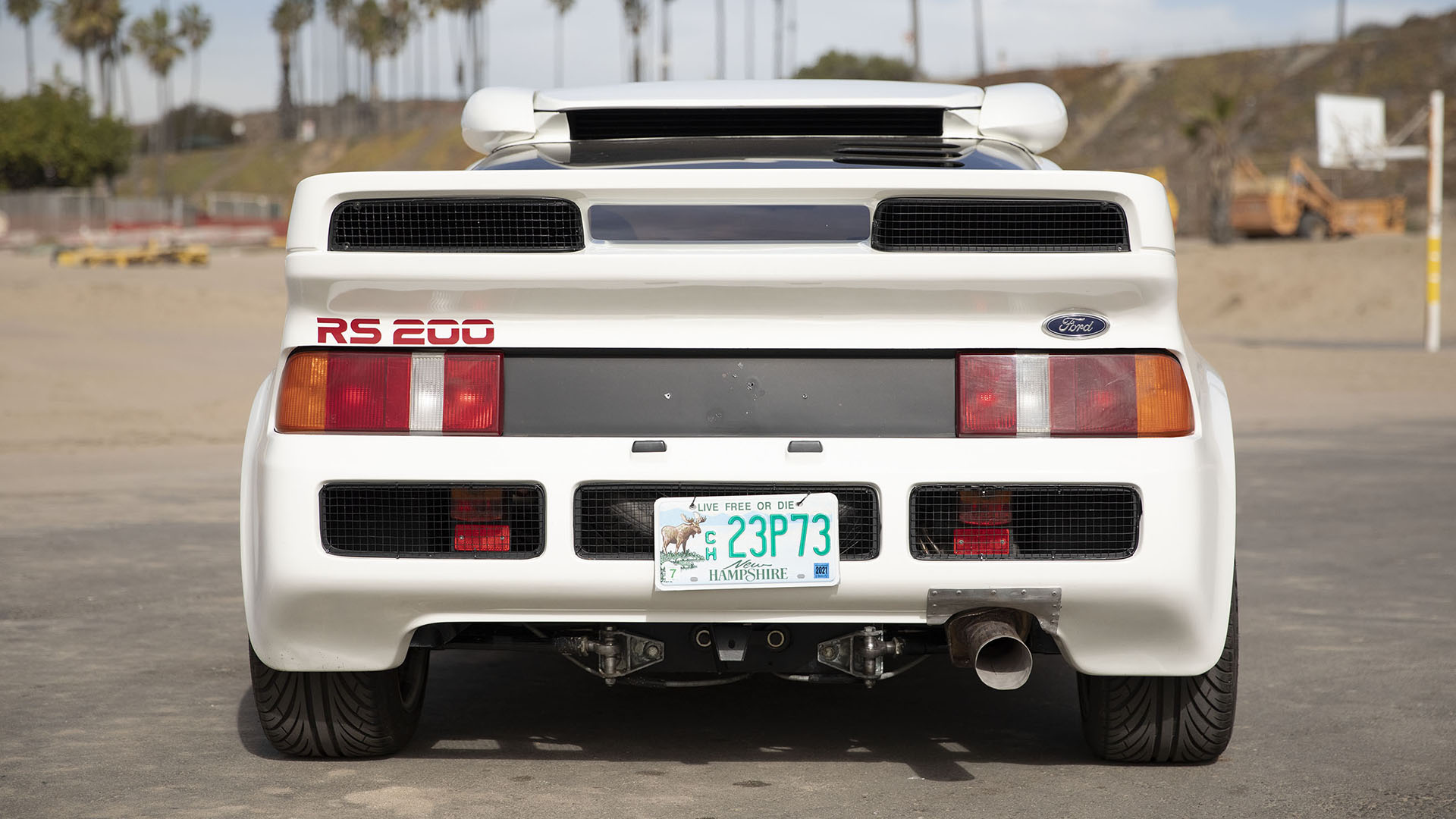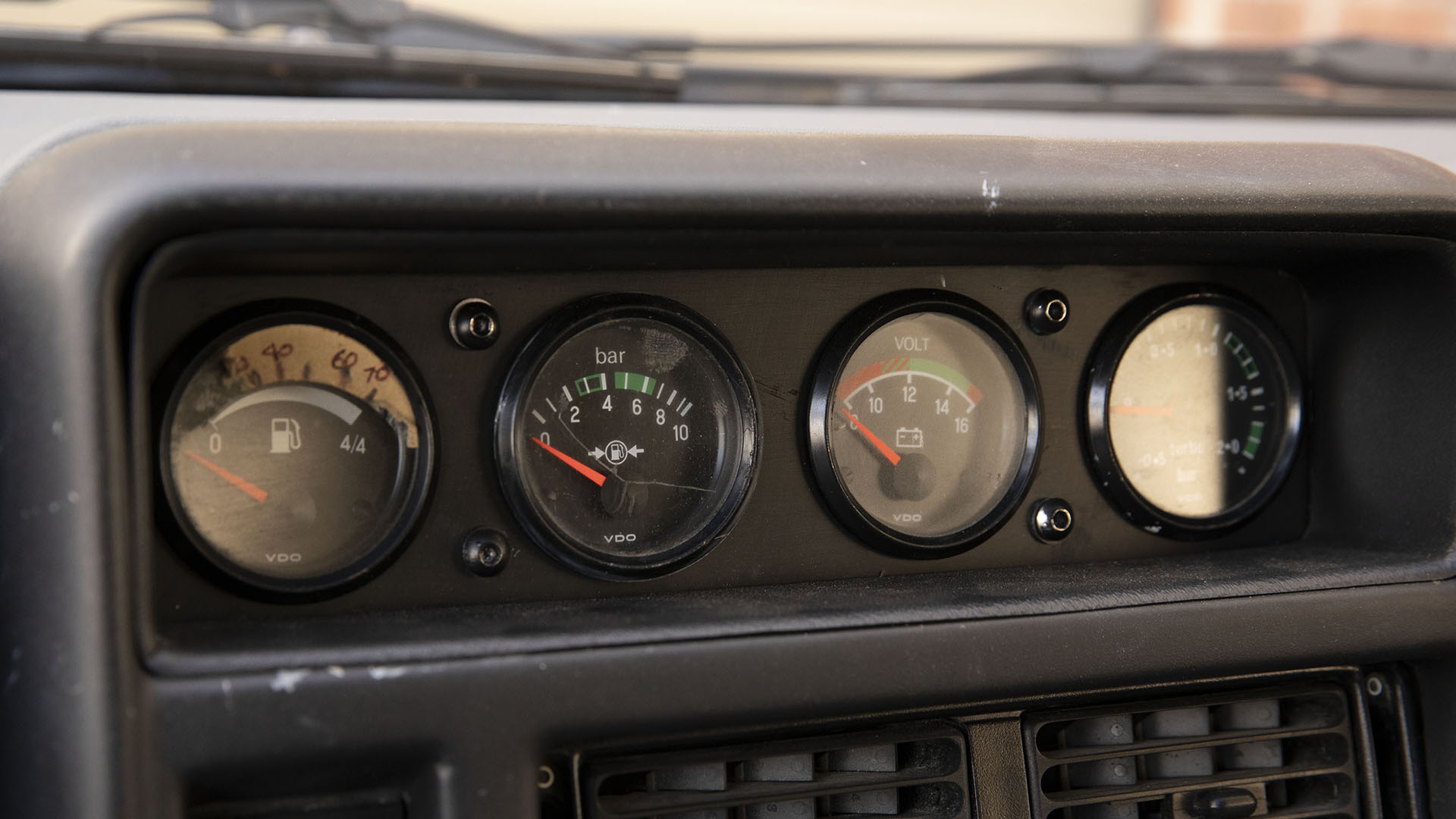It’s just two syllables. One letter, really. But exceedingly few names carry the same historical weight as Group B. The legendary, legendarily overpowered rally series from the go-go 1980s spawned some of the fastest, most powerful, and most capable race cars ever built—and thanks to the wonders of homologation, street-legal production versions that can only be described as personal rally machines.
And today, we’re driving one of the titans: a 1986 Ford RS200 Evo. Jealous? It’s okay, because you yourself might have the chance to do just that, provided you’ve got half a million (or more) bucks lying around. This very car, the car you see more often in extremely expensive online listings more than anywhere else these days, is indeed up for sale right now by a firm called Stratas Auctions. But you’ll have to be quick—the hammer drops tomorrow. Bidding’s at $355,000 as this story’s being published. Where will it end up? A bit higher, let’s just say.
In many ways, the RS200 is one of the Group B-iest Group B cars of them all—a clean-sheet design cobbled together with spare parts and sheer brilliance from a few determined engineers, not built out of an existing street car from Ford. In turn, that makes the mandated homologation special that much nuttier. This isn’t a Quattro or a Renault with box fenders or even a Lancia Delta Integrale. This is a Porsche 917-style fig leaf, an engineering exercise done to check a box without giving any thought to drivability or livability or comfort.
Still, we all look at something like the RS200 Evo, a limited run of 24 street cars with an even larger engine and more power, and think man, I would so daily drive that. But would you? Could you? It’s one thing to chuckle at stuff like the 600-horsepower Cosworth four-cylinder and non-synchronous transmission from a distance. It’s quite another to lurch half a million dollars of automotive history through a traffic-choked street grid and still emerge feeling like you made a wise decision to take the rally car to lunch.

I’m not Chris Harris, so this isn’t going to be a story of heroic powerslides and fine-edge control. Stratas Auctions was kind enough to toss me the keys for a couple hours on a weekday afternoon in Los Angeles and the testing conditions reflect that—highways, surface streets, the typical urban bag. But you don’t need me to tell you the RS200 can dance with the stars. The question is, can it also shuffle along with the rest of us?
The Ford RS200 Evo, By The Numbers
- Price: $500,000+ (auction estimates)
- Powertrain: 2.1-liter turbocharged Cosworth BDT-E inline-four | five-speed manual transmission | all-wheel drive
- Horsepower: 600
- Torque: 400 lb-ft
- 0-60 mph: 3.3 seconds (estimate)
- Curb Weight: 2,600 pounds
- Quick Take: An unrestrained rally racer for the street.
Group B: When Flying Cars Were Real
Introduced by the Fédération Internationale de l’Automobile (FIA) in 1982, the Group B was a rule set intended to spice up competition and encourage innovation in rallying and sports car racing. Accordingly, things were stunningly untethered—cars needed to be closed-roof and able to accommodate a driver and passenger in a side-by-side layout, while the minimum race weight and maximum tire width were determined by engine displacement and aspiration. Most everything else in terms of chassis design, dimensions, materials, and drivetrain configuration were unrestricted—including boost.
There was a catch, though: Group B required homologation. While the race cars didn’t need to be based on an existing production car, manufacturers would have to build a minimum of 200 road-going examples of the vehicle they wanted to campaign.

It was a recipe for small, lightweight, savagely powerful machines, and manufacturers were quick to seize upon the opportunity to produce rally cars that were largely free of compromise, ushering in a mind-boggling power-to-weight arms race in the World Rally Championship. Though it’s considered by many to be the golden era of rallying, by 1986 the inherent danger of the class had become too serious to ignore. In the wake of several horrific accidents and after just five seasons, the FIA chose to disband Group B.
Before that happened, though, Ford decided to abandon a problematic effort with the Escort RS 1700T in 1983 to design an entirely new vehicle around the Group B rule set, which in turn resulted in this fiberglass-bodied, mid-engined homologation car. Competition in Group B was incredibly fierce, with engine output more than doubling over the course of the class’s existence. This wasn’t lost on Ford. So, in the interest of staying competitive, the team began development work on an updated RS200 with the intention of campaigning it in the 1987 season.

Ford had planned to produce 20 homologation examples of the new RS200 iteration in accordance with Group B rules, but after the class was unceremoniously dissolved at the end of the 1986 season, Ford decided to modify 20 of the existing 200 RS200 chassis instead. Dubbed the RS200 Evolution, Ford later produced an additional four examples of the upgraded RS200 Evo, bringing the grand total to 24 cars in all.
Ford, Evolved
Although the RS200 benefitted from the lessons learned campaigning the Escort RS 1700T, it was a wholly unique machine. The chassis was designed by Ford engineers Tony Southgate and John Wheeler (both of whom had backgrounds in Formula One development) to accommodate a rear mid-mounted engine and an all-wheel drive system, while the five-speed manual transmission was mounted just behind the front axle for better weight distribution. Both the front and rear of the car scored independent double wishbone suspension systems while twin damper setups were outfitted at all four corners, along with ventilated disc brakes.







The composite bodywork was designed by Ghia, the back half of which raises up to reveal the engine bay in its entirety. A few parts bin concessions were made to cut down on development time and provide some semblance of aesthetic continuity with the rest of the Ford lineup, though, as evidenced by the Sierra-sourced windshield and tail lights.
Motivation for the original batch of RS200s was provided by a turbocharged version of the 1.8-liter 16-valve Cosworth BDA engine. Known as the BDT, the engine made 250hp in street car trim and roughly 500 in race specification. RS200 Evo models, on the other hand, benefited from a larger, 2.1-liter version of the BDT called the BDT-E.


Developed by noted race engine builder Brian Hart, the BDT-E used a bespoke aluminum block and benefited from turbo system upgrades aimed at supporting more boost. These mills are said to be capable of delivering well over 700 horsepower with relatively simple ECU tweaks, though I’m told by the folks at Stratas that the 600 horsepower tune that this Evo has seems to be the sweet spot in terms of balancing performance and reliability.
Driving the 1986 Ford RS200 Evo
Although mechanically sound with a fresh engine rebuild, this one’s not a museum piece. This particular RS200 Evo saw competition in hillclimb and rallycross events early in life before making its way in and out of a few collections, and it wears its history on its sleeve.
While I’m looking over the car, Stratas Auctions founder Lance Butler offers a word of caution. “Evos have either a synchronized transmission or a ‘crash box,’ and this one has the crash box,” he explains. “The synchro gearbox is much nicer for regular use, but the crash box is an actual race transmission. That’s great when you’re at a track—it adds to the experience. But in regular driving around town, the straight-cut gears can be a bit harsh.”
Mental note made. Hopping in and settling into the Sparco bucket, I’m immediately transported by the purpose-driven interior. Carpeting is one of the few luxuries that set the homologation cars apart from the race cars, but that’s long gone here, likely tossed out by the first owner back in the car’s motorsport days.




There’s a blank plate where the audio system would be, but it’s actually the absence of a roll cage that’s most noticeable given how intense the rest of it is. That sits in contrast to many of today’s production-based homologation cars, which are often marketed as “race cars for the street” but carry all sorts of weight-adding creature comforts. There’s nothing in the cabin of this car that has a purpose outside of going fast. And yet there’s a surprising amount of head and legroom, even for my 6’3 frame.
The clutch is race car-heavy, but all attention’s on the Cosworth power plant as it roars to life behind me. There’s a muffler back there, I swear, I saw it—but if I’d have blindfolded you and brought you along for the day (no, you can’t take it off, and you’re welcome, by the way, sheesh), you’d swear it’s straight piped. It’s loud, ferociously so when you get on it, this alive thing crackling with all manner of barks, wastegate whooshes and exhaust pops. We’ve all heard the sound, be it in person from the outside or on scratchy VHS tapes or on YouTube. To experience it boiling up behind you—to direct it—I think that’s probably worth the six-figure price.
But the engine, as it turns out, is in a constant battle for your attention with the transmission. Its straight-cut gears, laborious clutch, race-spec flywheel and small pedal box make each smooth take-off and quick shift feel like a small miracle, even for someone who’s spent years in LA traffic with three pedals.







In many ways, the transmission defines the character of the car. The gearing is dialed in for rally competition, specifically, and with 600 hp in a car that weighs less than a Subaru BRZ, it makes for stunning off-the-line acceleration that still rivals today’s burliest sports cars. There’s a reason this thing once held the Guinness World Record for 0-60 times. But it also means that the engine is wailing away at 6,000 rpm in fifth gear at about 80 mph on the freeway. Again, a great sound, but maybe too much of a good thing.
With a 15-20 mph spread between gears, a properly executed full-throttle pull from a dead stop equates to a fraction of a second spent winding through each of the first few gears. It also equates to potential bucking from the transmission when you’re cruising around in gear if there’s any significant fluctuation in speed. Between that and the need for near-perfect rev-matched downshifts in order to keep the gearbox happy, a brief stint in the RS200 Evo adds an entirely new level of respect for the racers who piloted these machines in competition back in the day.

Interestingly, the rest of the setup is forgiving. The steering is light, the brakes are responsive and low-effort; even the suspension is compliant, though it ought to be considering the demands of a rally stage. With a different gearbox it actually seems like it would be feasible to daily drive it, weather permitting. But that was never the plan for the RS200. This thing was designed to win rally races, and around-town drivability isn’t an element of race car design, homologation rules or not.
Still, the thrill of cruising around in a legitimate Group B rally car every day is tempting. I’m already scheming ways legal and otherwise to pull together a few hundred thousand dollars for a bid as I reluctantly pull back into the garage, where Butler doesn’t hesitate to bring me back down to Earth.
“Sure, you could daily drive it—as long as you don’t mind rebuilding the engine every 35 hours or so.”
Hmm, pass. But that’s to be expected. It’s just good to know that sometimes, your heroes are exactly who you think they are.

Got a tip? Send us a note: tips@thedrive.com
